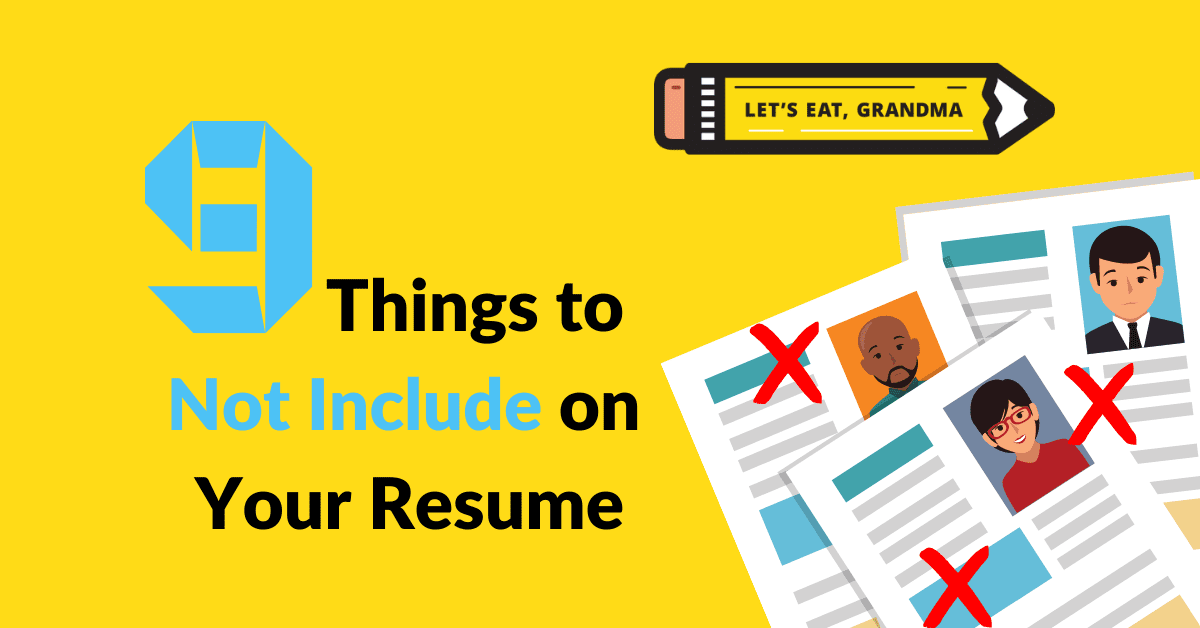What NOT to Put on a Resume: 9 Things to Avoid

Wondering what you need to put on your resume in 2021? Make sure your resume avoids these common pitfalls!
By: Grace Mitchell | Contributor for Let’s Eat, Grandma
Think you’re ready to send in your resume? Not so fast.
Your resume is an important opportunity to make a strong first impression with recruiters. It should clearly state your professional strengths and experience, demonstrating why you’d be a great asset to the company you’re applying for.
However, there are a few items that if included could seriously hurt your chances of making that impression.
Tired of not landing interviews?
Get our free 3-step guide to writing better resume bullet points, featuring 70 ideas for metrics you can use!
What to Avoid on Your Resume
At Let’s Eat, Grandma, we’ve written thousands of resumes, so we know what recruiters are currently looking for … and what they hate to see. Before you hit “send,” check your resume for these common mistakes.
1. An Objective Statement

Recruiters see tons of resumes for every job opening. Knowing these nine things not to include in your resume will ensure they remember yours. Photo by Magnet.me on Unsplash
Objective statements are the way of the past, and frankly a waste of valuable resume real estate. Try opening with a targeted Summary of Qualifications instead. This simple shift begins your resume with bold, decisive statements about what qualifies you for the specific job you’re applying to.
2. Your Full Address
Like an objective statement or an MSN email address, a full address automatically makes a resume look 10 years older, and not in a good way. After all, it’s unlikely that you and your hiring manager will be exchanging snail mail as part of the hiring process (or that you’ve sent or received mail about a job opportunity in over a decade).
Furthermore, submitting something as sensitive as your full home address to strangers online puts your security at risk, thanks to online weirdos like stalkers, nefarious darkweb salesmen, and other bogeymen your grandmother likely warned you about.
(Okay, so maybe your grandma has no idea what the darkweb is. But she’s right to be wary of giving personal information to strangers on the internet.)
Take a note from this Grandma and simply include your city and state in your resume heading, unless it’s different from the city where the job is. In this case, you can include your current city plus “commuting to” or “relocating to” the new city.
3. References
Your resume should be as concise as possible. If the job posting asks for references, you should include these in a brief additional document, with formatting that matches your resume and cover letter.
Also, please don’t waste valuable resume space telling your hiring manager that “references are available upon request.” Of course they are! Use that space to tell the reader something they don’t already know.
4. Irrelevant Work Experience
If you can’t directly translate the skills and experience from a past job into the one you’re applying for, leave it out! Your resume should include your most recent, relevant positions. If a past job is more relevant, say you’re returning to programming after a long absence, that takes precedence over your recent spur-of-the-moment theme park gig (even if the latter did make for some great stories).
However, if removing your less-relevant experience leaves you with huge gaps in your resume, you might choose to include the most recent jobs, but with fewer bullet points. List only the 2-3 most relevant bullets for these entries, and try to find ways to connect the experience to your current career aspirations. This is a great opportunity to focus on soft skills.
In some cases, you can also move less relevant experience to an “Additional Experience” section. Don’t worry about breaking chronology here! (Protip: Chronological isn’t the only acceptable resume format.)
5. Hobbies

Your interest in board games could be valuable for making work friends once you’re hired, but it isn’t something you should put on your resume. Photo by Clint Bustrillos on Unsplash
Unless the job description states that the ideal candidate has a passion for underwater basket-weaving, that passion is best left off your resume. Again, your resume has finite space, and you want to use that space for the skills and experience most relevant to the job you’re applying to.
We’re not asking you to give up your hobbies. We just want you to put your best foot forward so that you land your dream job.
Once you’ve got the job locked in, then you can get that after-work Dungeons and Dragons crew assembled.
6. Clichés
Your resume should give your hiring manager clear insight into your work experience. Telling them you’re a “seasoned people person with strong communication skills” doesn’t accomplish that.
Instead, give some thought to your unique experience, and give numbers to back up your accomplishments.
You’re better than resume clichés! Give your experience the fresh description it deserves.
7. Personal Pronouns
Resumes should be written in what’s called “absent” or “implied first-person.” This means that you should write your resume in first-person voice, without direct reference to “I.”
In other words, rather than “I trained 13 staff members,” your bullet point would read “Trained 13 staff members.” Not only does this give your resume a more professional feel, it also saves some valuable space!
8. Tables, Images, Columns, and Charts
If you include these in your resume, an Applicant Tracking System (ATS) could have trouble parsing your resume. Worse still, including graphics is a distraction for the human who might otherwise decide to hire you.
Your resume needs to quantify your experience, but this should be done using sentences and bullet points: the traditional resume writing methods that most recruiters prefer to read.
We’re sure your tables and charts are great, but these work way better in PowerPoint presentations than in resumes.
9. Your Headshot
Say it with us: I will not include a headshot in my resume. Not only does this make it difficult for an ATS to read your resume properly, it also opens the door unnecessarily for discrimination based on your appearance, race, sex, religion, age, ability, or any other sort of bias an employer might hold.
However, there is one great place for a headshot: Your LinkedIn profile! Accounts with headshots get more engagement, so that impressive shot could actually help you snag a job (in the proper context, of course).
Jumping Over the Hurdles
There you have it: the top nine things that you should not put on your resume. Made it through this obstacle course without changing your resume? Way to go!
If you didn’t, or you’re not sure what to include to fill in the gaps, check out our handy guide to building your resume from scratch. Happy job hunting!
Ready for more job search help?
Sign up for a free Senior Writer Resume Critique to see what's holding you back from landing interviews. One of our top professional resume writers will give you personalized feedback on the top 3 items you can improve based on our expert practices!
